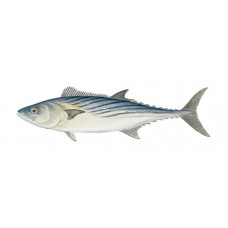Latin name
Sarda sarda
Other names
Common bonito, katonkel, belted bonito; French: bonito à dos rayé, boniton, conite, pélamide; Japanese: hagatsuo, kigungegatsuo; Portuguese: cerda, sarrajâo, serra; Spanish: bonito del Atlántico, cabaña cariba, cerda.
Identification
The Atlantic bonito belongs to a group in which the dorsal fins are very close together or separated by a narrow gap. Its body is completely covered with scales, with the scales around the pectoral fin and on the lateral line usually larger. They are distinguished from tuna by their compressed body, lack of teeth on the palate, and some differences in coloration. It can be distinguished by dark oblique stripes on the back and upper jaw, about half the length of the head.
Distribution
In North America, the Atlantic bonito inhabits the Atlantic Ocean from Nova Scotia to Argentina in the western Atlantic. In the United States, it is most common from southern New England to New Jersey. Atlantic bonito is rare in the Caribbean and the Gulf of Mexico.
Habitat
Atlantic bonito are found in brackish water and saltwater, especially in tropical and temperate coastal areas. They are gregarious and migratory fish and often inhabit surface coastal waters.
Size
The Atlantic bonito averages between 2 and 10 pounds, although it can reach 20 pounds and 36 inches in length. A specimen weighing 18 pounds, 4 ounces is a world record.
Life history and Behavior
In coastal waters, spawning occurs from January to July, depending on location (June and July in the western Atlantic). Bonito reach sexual maturity at about 16 inches in length. Spawning usually occurs close to shore, in warm coastal waters.
Food and feeding habits
The Atlantic bonito feeds on mackerel, menhaden, alewife, silverside, sand lance and other fish as well as squid.
Reproduction
First mature at the age of two years with a body length of 25 cm. Keeps in flocks. Spawning probably takes place in the tropics and subtropics year-round in the deep parts of the shelf, since the leptocephalus larvae of this species are caught above the shelf in different months of the year. The albula leptocephala is similar in shape to a willow leaf. The smallest size (57 mm, SL 51 mm) had leptocephales caught off the coast of Florida. After reaching a length of 8-9 cm (with a well-defined forked tail fin), leptocephali begin to shrink, their body shortens and thickens, at a length of about 3 cm their body becomes similar in shape to adult fish. Albules feed on worms, mollusks, shrimps, crabs and small fish.
Interesting facts
Water is many times denser than air, and it is not easy to move in it. But fish have to move: to get food, to escape enemies. And so, gradually, over many generations, they have developed special devices to facilitate movement, special techniques that allow you to swim easily and quickly. When the fish swim fast, they usually press the fins to the body, and at Sarda they are retracted into a special hollow. Sarda include 4 species: Australian bonito (Sarda australis), Eastern Pacific bonito (Sarda chiliensis), Striped bonito (Sarda orientalis), and Atlantic bonito (Sarda sarda).
| Classification | |
| Phylum | Chordata |
| Class | Actinopterygii |
| Squad | Scombriformes |
| Family | Scombridae |
| Genus | Sarda sarda |
| Species | S. sarda |
| Features | |
| Conservation status | Least Concern |
| Habitat | Littoral |
| Life span, years | 5 |
| Maximum body weight, kg | 5.4 |
| Maximum length, cm | 91.4 |
| Sailing speed, m/s | 27 |
| Threat to people | Edible |
| Way of eating | predator |


